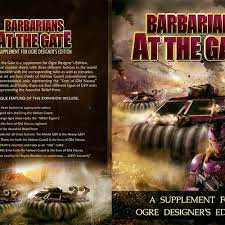Flicking through an old Strategy & Tactics magazine and this caught my eye.
Not sure I had seen a pre-SJG era advert previously.
I was home recently rummaging through some gaming storage to unearth my original OGRE stuff.
Amongst the various scribbles, notes and photocopies I found a true gem...
This is the original flyer I found posted at my local games shop while I was at University, around the release of first OGRE Miniatures rules. Looking at my subsequent postal correspondence with Warner (how old school is that!) it was early 1993 or so.
 |
| No, the postal address isn't current anymore! |
I'm thrilled to still have a copy of this - for me, it was truly the beginning of more than 30 years of re-dedicated interest in OGRE and getting involved with likeminded gamers, which was the genesis of the PanPac Alliance and the first website.
Thanks Warner! :-)
Thrilled this week to get in touch with Jesh of Jesh Art Designs, who designed one of the entries for the "Barbarians at the Gate" competition I mentioned in this post: https://panpacificalliance.blogspot.com/2025/03/barbarians-at-gate-art-designs.html
He replied to my inquiry this week with "I’m actually the artist behind that piece, and I truly love how it turned out. It’s still in my collection, and I’ve kept it all this time".
 |
| Full size final artwork, by Jesh Art Studios |
Jesh has very kindly provided me with all the versions he did, along with permission to post them here - thanks indeed Jesh!
Please respect the author's IP and
the spirit in which he has shared them
 |
| "Barbarians at the Gate" by Elartwyne Estole |
On rediscovering OGRE recently, I found out that there was (a decade ago) an artwork contest to design the cover of the independently published "Barbarians at the Gate" OGRE supplement by Drew Metzger. "99 designs" ran it and while IMHO they selected the best one, some of the others were quite good also but perhaps didn't get the circulation they deserve
The winning pic above, which many may be familiar with, was used in a wrap around book slip style so the front cover was the right hand side of the image, thus:
Clearly it had a few adjustments, like adding the GEV's missile rack and removing the aircraft. Evocative, dynamic, and contains everything from a GEV to Battlesuited infantry, and of course a hulking OGRE in the background. Cracking stuff by "El art"
But there were other entries of varying appeal. I'm trying to track down the original artists to get the original versions but given the elapsed time it's proving challenging. Here they are though:
 |
| by Andrew64 |
 |
| by *APRILILY* |
 |
| by *APRILILY* |
 |
| by Adrenaline Design |
 |
| by delatorre.elisa |
 |
| I don't have a "favourite" per se, but I like this one by Jesh Art Studio a lot... |
Very interesting to see that GEVs feature in most entries and an OGRE in just one. Makes you wonder what the original design brief was.
No infringement intended, my purpose is to capture and promote some great OGRE inspired artwork I hadn't seen before and thought many other may have missed it also. The full details are available here:
The penultimate upload of Steve Stratton's original artwork from the first website- this time the imagery is set in his own setting of the PanEuro offensive in Russia 2092. I always loved how Steve used historical imagery in this series
Continuing the upload of Steve Stratton's original artwork from the first website- this time the imagery is set in the Saharan Combat Zone (SCZ) and my PanEuro Afrika Korps project
Continuing the upload of Steve Stratton's original artwork from the first website- this time the imagery is set in the Antartica Disputed Zone (ADZ)
